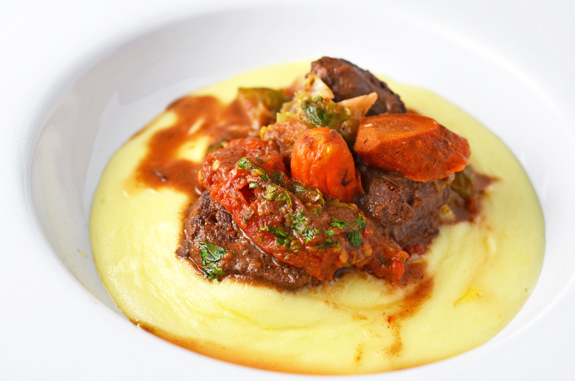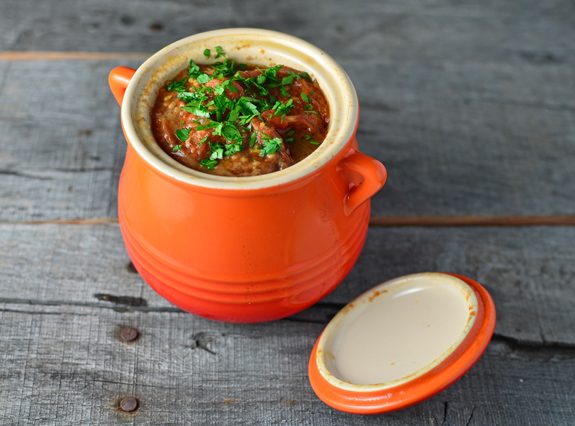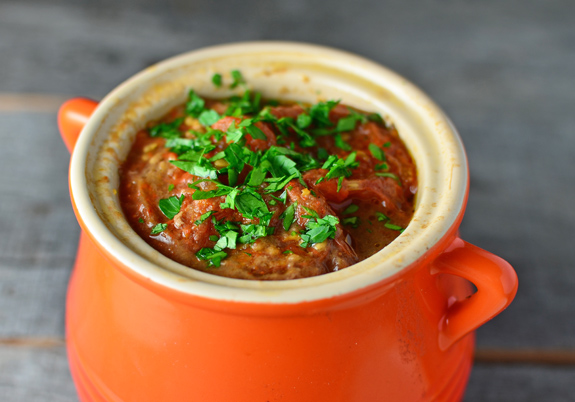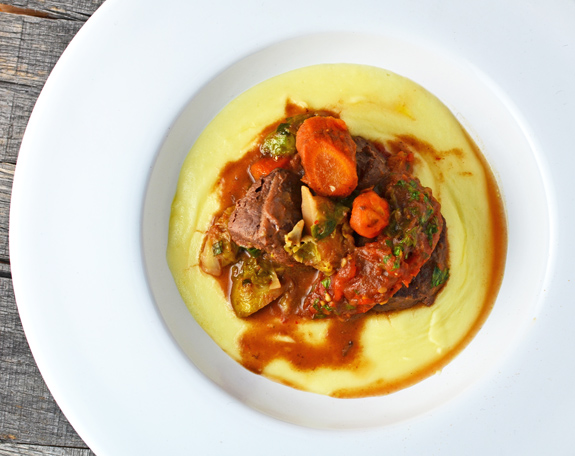Call it my resolution for 2015: I’ve decided to extend (complete?) my collection of national dishes this year. I’ve already covered Czech Republic, Poland, Ukraine, Azerbaijan, Georgia, Uzbekistan, Tajikistan, maybe a couple more, so I’ve got, what, a mere 20 countries left? Today is Bosnia’s turn, with Bosanski Lonac.
Bosanski Lonac simply means “Bosnian pot”, which makes me wonder if locals really call it that. After all, French fries are simply called fries in France, and Belgian waffles are just waffles in Belgium. Anyway, this is essentially a stew prepared by alternating layers of large pieces of meat and vegetables into a deep pot, and covering the whole thing with water.

In Alija Lakišić’s Bosanski kuhar, a lengthy tome dedicated to the cuisine of Bosnia and Herzegovina, one can learn more about the origins of the dish. Bosnia has long been a mining area, and lonac was created in the Middle Ages by coal miners for practical reasons. The miners had to prepare their own meals, so while they were working they would leave a ceramic pot filled with a simple but hearty affair of meat chunks, potatoes, and a few vegetables, thrown in in layers, to cook slowly over a fire hearth, until lunch break. Pots were typically prepared for a group of people, and each pot was marked with the name of the group to avoid confusion. Later on, the dish spread beyond coal miners, and people started bringing their pots to bakeries, where they could be cooked slowly in the bread ovens once the baking was done.
The most common meats used in lonac are lamb and beef (pork is obviously a bad idea, what with Islam being the main religion in Bosnia). As for the vegetables, cabbage, potatoes, carrots, and tomatoes are the norm, although Lakišić claims that cabbage is heresy. Many regional variations exist, some of them adding multiple cuts of meat, ground meat, or even kebabs on the side. In a fish version, meat is replaced with carp. One sometimes sees the inclusion of eggplants, green peppers, or rice.
I must disclose that I’ve not yet been to Bosnia and have therefore not tasted a Bosanski lonac in its natural environment. Nevertheless, I think I get the idea and I’ve got a few tricks in my bag. Since this is a stew with lots of vegetables and without heavy sauce (no cream or butter), I’ve kept the fat content to a bare minimum, thickening the sauce with puréed vegetables. For balance, I serve it with a rich potato purée — a little bit like the goulash at Hospoda that I reviewed recently. I’ve kept the traditional vegetables, minus the potatoes (because we have the purée), and with Brussels sprouts instead of plain cabbage (same family). However, the vegetables are cooked separately so as to preserve their individual flavors instead of making then into some indistinct blend. I’m using venison for the meat, which works beautifully and I happen to have a lot of it in my fridge, but you could replace this with lamb shoulder or beef brisket. Slowly cooking the meat sous-vide produces an optimally tender and moist result. Finally, while the traditional lonac is cooked and served in a large pot, I’ve opted for cute little Le Creuset bean pots instead.

Venison stock
Yields 8 servings
120 g peeled celery root, large dice
120 g peeled carrot, large dice
240 g peeled onion, large dice
1 peeled garlic clove
20 g olive oil
salt
300 g venison bones
3 sprigs parsley
1 clove
120 g red wine
360 g water
- In a pressure cooker over medium heat, sauté the celery root, carrot, onion, and garlic in the olive oil until golden brown. Season with salt, then add the venison bones. Cook for a few minutes, stirring regularly.
- Add the parsley, clove, and red wine, and simmer for a couple minutes.
- Pour in the water, and cover with the lid. Bring to pressure, then cook for 1 hour. Let rest until the pressure goes down.
- Strain the stock in a colander. Weigh about 100 g of the stock vegetables, and process with the liquid in a blender. Let cool, and discard the bones and the rest of the vegetables.
Sous-vide venison stew
Yields 8 servings
1500 g boneless, cleaned venison leg
salt
black pepper, ground
60 g olive oil
venison stock (whole amount from above recipe)
- Cut the venison meat into 4 cm cubes, and season with salt and pepper. In a pot over high heat, sauté in olive oil until brown on all sides.
- Transfer the meat to a sous-vide pouch, pour in the venison stock, and vacuum seal. Cook in a 65 C / 149 F water bath for 36 hours. Reserve.
Vegetable preparation
Yields 8 servings
500 g tomatoes
55 g olive oil
salt
280 g peeled carrots
240 g cleaned Brussels sprouts, quartered
- Cut the tomatoes in half, and place cut-side-up in an oven-proof dish.
- Drizzle with 1/3 of the olive oil, season with salt, then bake in a 220 C / 425 F oven for 1 hour. Reserve.
- Cut the carrots into large chunks. Place in another oven-proof dish, drizzle with 1/3 of the olive oil, and season with salt. Bake in a 220 C / 425 F oven for about 1 hour (more or less, depending on the size of the carrots), shaking the dish every 20 minutes or so.
- In a pan over medium heat, sauté the Brussels sprouts in the rest of the olive oil. Season with salt, cover, and cook until brown and tender, stirring regularly. Reserve.
 Bosanski lonac
Bosanski lonac
Yields 8 servings
sous-vide venison stew
salt
piment d’espelette
prepared vegetables (tomatoes, carrots, Brussels sprouts)
parsley, finely chopped
- Assemble the lonac in four small 1/2-liter pots, or one large 2-liter pot. Open the stew sous-vide pouch, and make a first layer with chunks of meat. Cover with stock from the stew, then season with salt and piment d’espelette. Cover with all of the carrots. Make another layer of meat chunks, cover with stock, season with salt and piment d’espelette. Cover with all of the Brussels sprouts. Make a last layer of meat chunks, cover with stock, season with salt and piment d’espelette. Peel the tomato halves, and arrange them on top of the meat. Pour any leftover stock. If time permits, refrigerate for a few hours or overnight.
- Reheat the lonac, covered with a lid, in a 120 C / 250 F oven until hot.
- Sprinkle with chopped parsley, and serve immediately on top of potato purée.
Potato purée
Yields 8 servings
1100 g peeled Yukon Gold potatoes, cut into 1″ slices
salt
250 g heavy cream
160 g milk
160 g butter
1 pinch ground nutmeg
- Bring a pot of unsalted water to 80 C / 175 F. Add the potatoes, and cook for 30 minutes, maintaining the water temperature at 70 C / 160 F (if you use a lot of water and cover the pot with a lid, the temperature should remain almost constant without you having to do anything). With a large spoon or spatula, transfer the potatoes to a bowl of ice water, and let cool completely.
- Bring the same pot of water up to a boil and salt the water. Add the potatoes back in, and simmer until cooked.
- Pass through a food mill fit with the finest disk; if necessary, use some of the cream to get the grinding going. Mix the potatoes with the heavy cream, milk, butter, and nutmeg, then push the mixture through a sieve — you can either pass it through a conical sieve with a ladle, or rub it through a drum sieve with a spatula.
- Gently reheat the purée, and serve in bowls with bosanski lonac on top.


